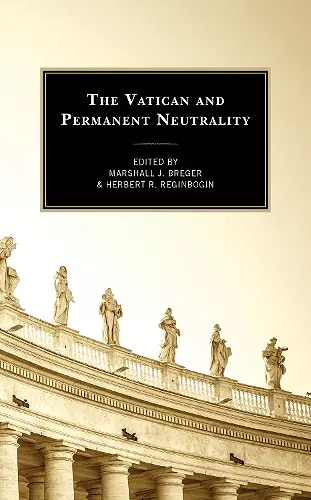The Vatican and Permanent Neutrality
Herbert R Reginbogin editor Marshall J Breger editor
Format:Hardback
Publisher:Lexington Books
Published:22nd Mar '22
Currently unavailable, and unfortunately no date known when it will be back

The essays in this book cover a fast-paced 150 years of Vatican diplomacy, starting from the fall of the Papal States in 1870 to the present day. They trace the transformation of the Vatican from a state like any other to an entity uniquely providing spiritual and moral sustenance in world affairs. In particular, the book details the Holy See’s use of neutrality as a tool and the principal statecraft in its diplomatic portmanteau. This concept of “permanent neutrality,” as codified in the Lateran Treaties of 1929, is a central concept adding to the Vatican's uniqueness and, as a result, the analysis of its policies does not easily fit within standard international relations or foreign policy scholarship. These essays consider in detail the Vatican’s history with “permanent neutrality” and its application in diplomacy toward delicate situations as, for instance, vis a vis Fascist Italy, Nazi Germany, and Imperial Japan, but also in the international relations of the Cold War in debates about nuclear non-proliferation, or outreach toward the third world, including Cuba and Venezuela. The book also considers the ineluctable tension between pastoral teachings and realpolitik, as the church faces a reckoning with its history.
What kind of an international actor is the Holy See? This question is asked and answered in this remarkable, wide-ranging volume by a number of leading scholars. This book travels from Rome to the Philippines; and from the papacy of Leo XIII to that of Pope Francis. This kind of breadth is challenging, and therefore rare, but it is the only way to analytically grasp the Vatican as an institution with truly global interests. The contributions are linked by an attempt to understand what, precisely, neutrality might mean in an age when the lines between neutrality and complicity were so blurred. The Vatican, not without controversy, has pioneered a way to remain technically neutral while also retaining enormous influence. The authors here utilize an enormous archive to understand how that strategy emerged, and what its record has been. It remains to be seen what will become of it in the twenty-first century, but anyone seeking to answer that question ought to begin, with this volume, by understanding its origins.
-- James Chappel, Duke UniversityIn this new study, Marshall Breger and his contributors unravel the often puzzling character of the Holy See’s neutrality in international affairs. As a history of diplomatic neutrality, it will interest international relation specialists. As an examination of Vatican diplomacy after the fall of the Papal States in 1870, it will be of special interest to scholars of Vatican affairs. Its most notable contribution, however, is of ‘the positive neutrality’ that works for peace and the liminal diplomacy of Pope Francis’ pontificate. Highly recommended.
-- Drew Christiansen, Georgetown UniversityHow can the Church offer moral guidance to believers making sense of a confusing world when the Vatican maintains strict neutrality toward nation states—even those ruled by criminals? This volume's authors bring unparalleled learning to this urgent and troubling question, but ultimately leave judgments where they should be: with their readers.
-- John Connely, University of California, BerkeleyThe oldest sovereign in the international community, the Holy See combines the transcendent dimension of the Church and its adaptation to changing historical circumstances. This book masterly illustrates and discusses how the two dimensions interact in the rise of the Holy See as a unique experiment of both neutrality in diplomacy and stewardship of the global contemporary world.
-- Marco Ventura, University of SienaIn 1994, John F. Pollard and I published a collection of essays titled Papal Diplomacy in the Modern Age. These essays resulted from a conference that had brought together leading scholars of the diplomacy of the Holy See in the nineteenth and twentieth centuries. This book on The Vatican and Permanent Neutrality, is an effective sequel to our earlier book, picking up the story from the commitment to neutrality in the Lateran Agreements and examining what neutrality meant to the Holy See during the Holocaust, the Cold War and the aftermath of Vatican II. Chapters from the late twentieth century and the early twenty-first century examine the Vatican role in nuclear non-proliferation especially after the fall of the Soviet Union. This book concludes on a contemporary note with the goals of Pope Francis in dealing with child sex abuse, wars in the Middle East, and the nuclear arsenal of North Korea.
-- Peter C. Kent, University of New BrunsISBN: 9781793642165
Dimensions: 227mm x 161mm x 31mm
Weight: 667g
322 pages